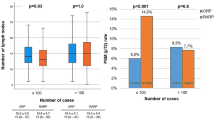Abstract
The aim of this study is to explore the use of pathologically confirmed capsular incision and denudation as a measure of adequacy of extirpation following robot-assisted laparoscopic prostatectomy (RALP). All patients who underwent RALP at the George Washington University Medical Center during the first 2 years of inception of the robotic prostatectomy program were included. All pathologic specimens were reviewed by a single pathologist. One hundred twenty-eight men who underwent RALP during the first 2 years were identified. Sixty-four patients underwent RALP during the first year (group 1) and all pathologic specimens were reviewed retrospectively. Sixty-four patients underwent RALP during the second year (group 2) after revision of our operative technique and all pathologic specimens were reviewed prospectively. Of patients in group 1, 18 (28%) had a positive surgical margin (PSM), and 18 (28%) with negative surgical margins were found to have capsular incision or denudation. In group 1, 32 (50%) patients had evidence of iatrogenic capsular violation. Group 2 consisted of 13 (20%) patients with a PSM and 9 (14%) margin-negative patients with capsular incision or denudation. Group 2 had a total of 22 (34%) patients with evidence of iatrogenic capsular violation. Overall reduction in positive margins was not statistically significant between the groups. Improvement in capsular incision/denudation rate and overall capsular violation between the two groups was statistically significant (P < 0.03 and <0.0055). Surgical margin status alone underestimates the overall quality of surgical resection after RALP because not all capsular violations result in a PSM. Surgeon-guided pathologic review in addition to intraoperative experience may improve oncologic success during the RALP learning curve.

Similar content being viewed by others
References
Ayyathurai R, Manoharan M, Nieder AM et al (2008) Factors affecting erectile function after radical retropubic prostatectomy: results from 1620 consecutive patients. BJU Int 101:833–836. doi:10.1111/j.1464-410X.2007.07409.x
Kundu SD, Roehl KA, Eggener SE et al (2004) Potency, continence and complications in 3, 477 consecutive radical retropubic prostatectomies. J Urol 172:2227–2231. doi:10.1097/01.ju.0000145222.94455.73
Klein EA, Bianco FJ, Serio AM et al (2008) Surgeon experience is strongly associated with biochemical recurrence after radical prostatectomy for all preoperative risk categories. J Urol 179:2212–2216. doi:10.1016/j.juro.2008.01.107
Vickers AJ, Bianco FJ, Serio AM et al (2007) The surgical learning curve for prostatectomy for prostate cancer. J Natl Cancer Inst 99:1171–1177. doi:10.1093/jnci/djm060
Swindle P, Eastham JA, Ohori M et al (2008) Do margins matter? The prognostic significance of positive surgical margins in radical prostatectomy specimens. J Urol 179:S47–S51. doi:10.1016/j.juro.2008.03.137
Karakiewicz PI, Eastham JA, Graefen M et al (2005) Prognostic impact of positive surgical margins in surgically treated prostate cancer: multi-institutional assessment of 5831 patients. Urol 66:1245–1250. doi:10.1016/j.urology.2005.06.108
Epstein JI (2001) Pathologic assessment of the surgical specimen. Urol Clin North Am 28:567–594. doi:10.1016/S0094-0143(05)70164-6
Savera AT, Kaul S, Bandani K et al (2006) Robotic radical prostatectomy with the “Veil of Aphrodite” technique: histologic evidence of enhanced nerve sparing. Eur Urol 49:1065–1073. doi:10.1016/j.eururo.2006.02.050
Sutherland DE, Bianco FJ, Tran HS et al (2008) Achieving oncologic efficacy with robotic prostatectomy: reassessing the learning curve. In: 66th Annual MA AUA Meeting Cambridge, MD, 2008 Mid-Atlantic AUA Meeting Poster session abstract, p 4, 25 Sept 2008
Lavery HJ, Ahlering T, Tewari A et al (2007) The advanced learning curve in robotic-assisted laparoscopic radical prostatectomy: a multi-institutional survey. Urology 70(Supp 3A, Podium session abstract POD-01.05):2
Ahlering TA, Skarecky D, Lee D et al (2003) Successful transfer of open surgical skills to a laparoscopic environment using a robotic interface: initial experience with laparoscopic radical prostatectomy. J Urol 170:1738–1741. doi:10.1097/01.ju.0000092881.24608.5e
Atug F, Castle EP, Srivastav SK et al (2007) Positive surgical margins in robotic-assisted radical prostatectomy: impact of learning curve on oncologic outcomes. Eur Urol 49:866–868. doi:10.1016/j.eururo.2006.02.054
Author information
Authors and Affiliations
Corresponding author
Rights and permissions
About this article
Cite this article
Williams, S.B., Sutherland, D.E., Frazier, H.A. et al. Pathologic analysis of capsular and incisional denudation and positive margin status in the development of a robot-assisted laparoscopic prostatectomy program. J Robotic Surg 3, 137–140 (2009). https://doi.org/10.1007/s11701-009-0148-4
Received:
Accepted:
Published:
Issue Date:
DOI: https://doi.org/10.1007/s11701-009-0148-4




